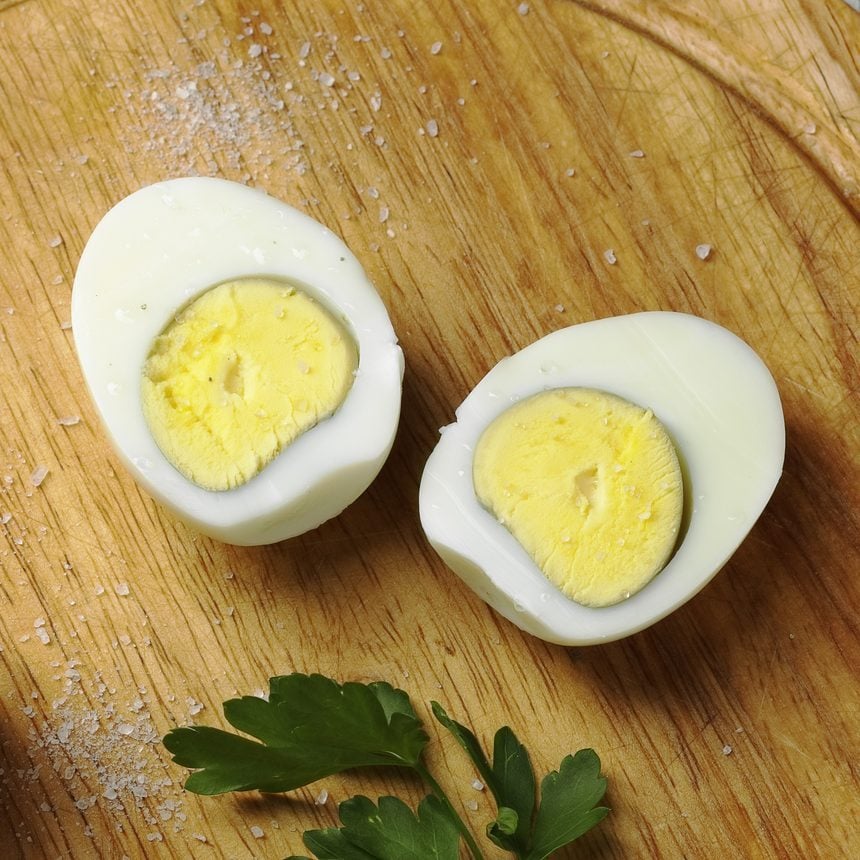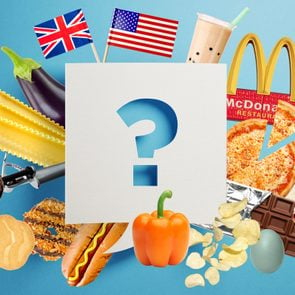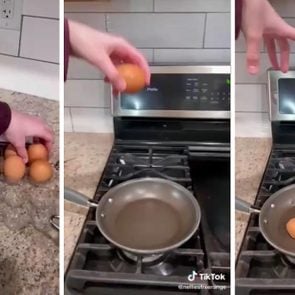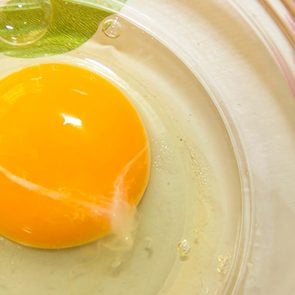If you're wondering why your hard-boiled eggs sometimes have green yolks, here's how to go for the gold

Solved! Here’s Why Your Hard-Boiled Eggs Have Green Yolks

Whether you’re making deviled eggs for a summer picnic or whipping up egg salad for sandwiches, it’s extremely disconcerting when you slice open that first egg and discover the dreaded green hard-boiled egg yolk waiting inside. What’s going on?
Many of us feel pretty confident about how to make scrambled eggs and even how to peel or cut hard-boiled eggs, but this Dr. Seuss stuff can be baffling. Are those green egg yolks safe to eat—and, if so, will they taste weird? Can your favorite fluffy scrambled eggs turn green too? And while we’re at it, do eggs need to be refrigerated? We’ve assembled all the info you need to avoid cooking up a batch of eggs with green yolks.
Get Reader’s Digest’s Read Up newsletter for more food facts, travel, tech and humor all week long.
What causes a green hard-boiled egg yolk?
It’s all about heat, according to Dawn M. Bohn, PhD, a teaching associate professor in the Department of Food Science and Human Nutrition at University of Illinois at Urbana-Champaign. Just like overcooking can screw up a batch of scrambled eggs, aggressively boiling eggs will cause a green hard-boiled egg yolk. “When an egg is cooked for too long and/or at too high a temperature, the sulfur in the egg white combines with the iron in the yolk and creates ferrous sulfide, which has a green tint,” she explains.
Unfortunately, this chemical reaction—which scientists call denaturation—isn’t limited to hard-boiled eggs. Using too much heat can give scrambled eggs and omelets a greenish cast as well. Luckily, mastering how to make scrambled eggs correctly is a snap (you can even make microwaved scrambled eggs!) and will help you avoid a potential green-egg situation.
Is it safe to eat a discolored egg yolk?
They may look unappealing, but yes. While green hard-boiled egg yolks might be visually off-putting and have a bit of a chalky texture, they are safe to eat. “The ferrous sulfide that’s formed when the egg is overcooked is actually the same form of iron you find in iron supplements,” says Stephanie Smith, PhD, an assistant professor at the Washington State University School of Food Science. “From a food safety perspective, it’s actually safer to eat overcooked eggs rather than undercooked eggs, which can harbor bacteria.” Duly noted!
That bacteria she refers to, salmonella, is estimated to lurk in one of every 20,000 eggs and can lead to food-borne illness. Besides ensuring that eggs are fully cooked, it’s important to remember that to stay safe for consumption, they should be kept in the fridge and eggs should never be washed. If you’re not sure if they’re fresh, here’s how to tell if your eggs are still good.
What color should a hard-boiled egg yolk actually be?
There’s a range of yellow and orange colors that can show up when you crack open an egg. Since an egg yolk’s color is determined by what the hen ate, the proper color of a well-cooked egg yolk can range from butter yellow to bright dandelion. A slightly undercooked hard-boiled egg will lean more orange than yellow, with a texture that’s a bit fudgier than that of a fully cooked egg.
How to hard-boil eggs to avoid green yolks
The best way to make hard-boiled eggs is to actually not boil them at all. Here’s how to do exactly that, according to Smith.
- Carefully remove the eggs from the carton and place in a saucepan.
- Fill the pan with enough water to cover the eggs, and place over medium-high heat.
- As soon as the water boils, turn off the heat and cover the pot. Let the eggs stand in the water for 12 minutes for medium eggs and 18 minutes for extra-large eggs.
- Remove the eggs from the pan and cool quickly—Smith suggests placing them in a bowl of ice water.
Once the eggs have cooled, it’s time to peel them. Though the shells of older eggs slide off more easily than those of new ones, knowing how to peel hard-boiled eggs is a skill worth learning. Not surprisingly, there’s also a correct method for cracking eggs, which is particularly useful if you’re making a big batch of Dolly Parton’s scrambled eggs for breakfast.
What to do with green-yolked eggs
Eggs are expensive these days, so rather than wasting food, you can camouflage those green hard-boiled egg yolks. Since avocados are already green, hide yolks in plain sight on your avocado toast, either by mashing them into the avocado or flip-flopping the presentation and placing the sliced eggs underneath the avocado. Another option is to stir fresh herbs like parsley or basil, chopped green olives or capers into your egg salad, all of which have the added benefit of masking any “off” flavors.
Next, find out if you can hard-boil eggs in an oven.
Sources:
- Dawn M. Bohn, PhD, teaching associate professor in the department of food science and human nutrition at University of Illinois at Urbana-Champaign
- Stephanie Smith, PhD, assistant professor at Washington State University School of Food Science























